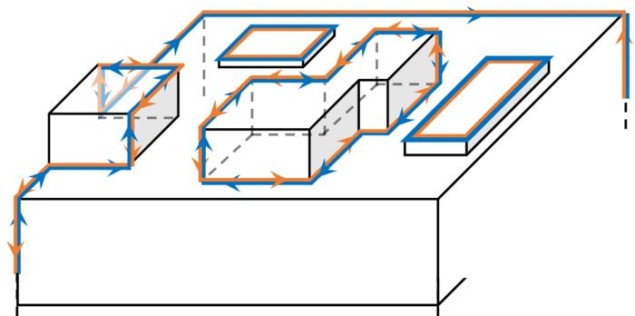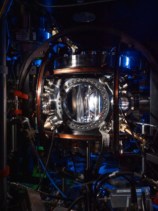
A newly-discovered “surface signature” of materials known as higher-order topological insulators could make them easier to identify – a task that has proved challenging until now. The technique, which was developed by researchers in the US, France, China and Ireland, would involve measuring changes to the polarization of an incoming light beam as it reflects off the material’s surface. Though not yet demonstrated experimentally, the technique could prove useful for developing quantum computers and spintronics devices that exploit the properties of these unusual materials.
Discovered in 2008, topological insulators are materials that conduct electricity very well along their edges or surfaces while acting as insulators in their bulk. In some topological insulators, the edge-state electric current induces a transverse spin current. These materials are known as quantum spin Hall systems by analogy with the better-known quantum Hall effect, in which strong magnetic fields induce electric current to flow along the edge of a semiconductor.
Within a topological insulator’s edge states, electrons can only travel in one direction. Unlike in normal conductors, they do not backscatter. This remarkable behaviour allows topological insulators to carry electrical current with near-zero dissipation – a property that attracts considerable interest among developers of electronic devices, who hope to exploit it to make such devices far more energy-efficient than they are today.
Over the last decade or so, additional topological materials (including Dirac semimetals, Weyl semimetals and axionic insulators) have emerged with even stranger properties. Most recently, materials that are insulating in their bulk, on their surfaces and along their edges, but conducting at hinges or corners, have been theorized to exist. The hinge states in these so-called higher-order topological insulators (HOTIs) are interesting for the study of spintronics because the direction of electron propagation in them is related to the electrons’ spin. HOTIs also hold promise for Majorana fermions, which have applications in fault-tolerant quantum computing – provided they can be definitively proven to exist.
Difficult to distinguish from other effects
In principle, HOTIs are highly distinctive because they only conduct electricity along one-dimensional lines on their surface – that is, along the boundary of a boundary. In practice, however, they are difficult to detect because other phenomena (including crystalline defects in a sample) can produce similar experimental signatures. To complicate matters, HOTI properties are only predicted to occur in materials with an unusually high degree of symmetry, explains Barry Bradlyn, a physicist at the University of Illinois at Urbana-Champaign, US, who co-led the new study. “This requires crystal structures that are unrealistically perfect and, until now, only a handful of materials, including the element bismuth, have demonstrated experimental signatures consistent with this category of material,” Bradlyn says.
In their work, which is detailed in Nature Communications, Bradlyn and colleagues analysed electrons propagating though the bulk of a HOTI, focusing on the electrons’ spin, which can be either up or down. If an electrical voltage were applied to the sample, these two spin states would accumulate on opposite sides. The researchers calculated that this spin configuration would produce a measurable signature via a phenomenon known as the magneto-optic Kerr effect, in which the polarization of an incoming light beam changes when it reflects off the surface of a sample.
According to the team’s calculations, the polarization change resulting from each spin state at the surface of a HOTI material would be exactly half that expected for an ordinary 2D insulating surface. “This ‘spin-resolved’ response at the surface is exciting,” says Bradlyn, “as it gives the first prediction for a robust experimental signature for HOTI materials.”

A periodic table for topological materials
The properties of HOTIs that the team identified in this work could be very useful in quantum computing and spintronic devices, Bradlyn continues, though researchers would need to see them in an experiment first. “We hope that our study shows that the insides and surfaces of topological materials still host many mysterious and advantageous features if you know how to look for them,” he says.
The researchers are now trying to extend their formalism to analyse topological crystalline insulators protected by other symmetries. “We will also be looking into superconducting systems,” Bradlyn tells Physics World.
- SEO Powered Content & PR Distribution. Get Amplified Today.
- PlatoData.Network Vertical Generative Ai. Empower Yourself. Access Here.
- PlatoAiStream. Web3 Intelligence. Knowledge Amplified. Access Here.
- PlatoESG. Carbon, CleanTech, Energy, Environment, Solar, Waste Management. Access Here.
- PlatoHealth. Biotech and Clinical Trials Intelligence. Access Here.
- Source: https://physicsworld.com/a/surface-signature-could-distinguish-exotic-topological-insulators/
- :has
- :is
- :not
- $UP
- 135
- 2008
- 2D
- a
- Accumulate
- acting
- Additional
- advantageous
- allows
- along
- also
- among
- an
- analyse
- and
- applications
- applied
- ARE
- AS
- At
- Attracts
- BE
- Beam
- because
- been
- behaviour
- boundary
- but
- by
- calculated
- calculations
- CAN
- carry
- Category
- challenging
- change
- Changes
- characteristic
- China
- colleagues
- College
- computers
- computing
- Conduct
- conducting
- Configuration
- considerable
- consistent
- continues
- corners
- could
- Crystal
- Current
- decade
- Degree
- demonstrated
- detailed
- detect
- developed
- developers
- developing
- Devices
- diagram
- difficult
- direction
- distinctive
- distinguish
- do
- down
- drawing
- each
- easier
- Edge
- effect
- either
- Electric
- electricity
- Electronic
- electrons
- element
- emerged
- Engineering
- Even
- exactly
- exciting
- exist
- Exotic
- expected
- experiment
- experimental
- Explains
- Exploit
- extend
- far
- Features
- Fields
- First
- flow
- focusing
- For
- France
- from
- gives
- Half
- Hall
- handful
- Have
- he
- High
- highly
- Hinge
- hinges
- hold
- hope
- host
- How
- How To
- However
- http
- HTTPS
- identified
- identify
- if
- illinois
- in
- Including
- Incoming
- induces
- information
- interest
- interesting
- into
- involve
- ireland
- issue
- IT
- jpg
- Know
- known
- Last
- light
- lines
- Look
- looking
- make
- many
- material
- materials
- Matters
- max-width
- measuring
- more
- most
- mysterious
- Need
- New
- normal
- now
- occur
- of
- off
- on
- ONE
- only
- opposite
- or
- ordinary
- Other
- our
- perfect
- periodic
- phenomenon
- photo
- physicist
- Physics
- Physics World
- plato
- Plato Data Intelligence
- PlatoData
- practice
- predicted
- prediction
- principle
- produce
- promise
- properties
- property
- protected
- Prove
- proved
- proven
- provided
- Quantum
- quantum computers
- quantum computing
- recently
- reflects
- related
- remarkable
- requires
- researchers
- response
- resulting
- robust
- sample
- says
- see
- semiconductor
- showing
- shown
- Shows
- Sides
- signature
- Signatures
- similar
- So
- some
- Spin
- State
- States
- Still
- stranger
- strong
- structures
- Study
- such
- superconducting
- Surface
- Systems
- table
- Task
- team
- technique
- tells
- than
- that
- The
- their
- Them
- These
- they
- this
- though?
- thumbnail
- to
- today
- travel
- trying
- two
- university
- unlike
- until
- us
- useful
- very
- via
- Voltage
- was
- WELL
- were
- when
- which
- while
- WHO
- will
- with
- without
- Work
- world
- would
- yet
- You
- zephyrnet













